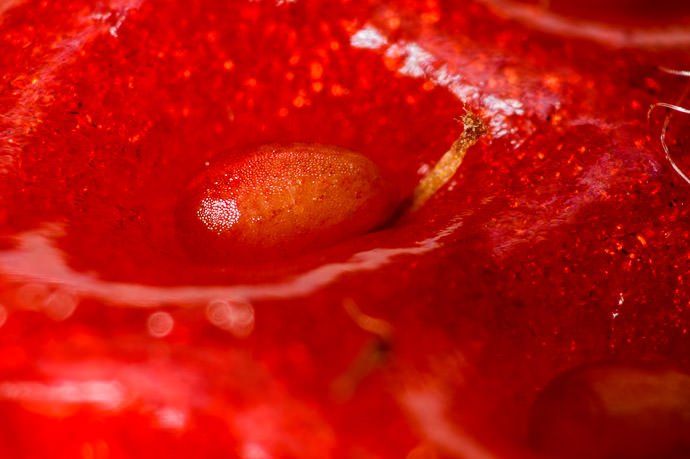
Nikon D4 + Venus 60mm Super Macro f/2.8 + 68mm extension tubes + 2x teleconverter — 1/60 sec, f/8, ISO 100 — map & image data — nearby photos
Mango Plunging Into a Huge Vat of Red Goop
Splat!
After seeing it mentioned on PetaPixel earlier this month, I ordered a Venus (LAOWA) 60mm f/2.8 Ultra-Macro lens. For less than $400 I didn't expect much, but it was worth a try.
(It seems they're changing their name from “Venus” to “Laowa”. The Chinese characters for “Laowa” seem to be 「老蛙」, which means “Aged Frog”, at least in Japanese.)
This is not a “review”... just some observations that I haven't seen others make yet, and some illustrative photos. In addition to the review on PetaPixel, other reviews I've seen include this and this.
For the TL;DR crowd, here in short are some of the things I discuss that I've not seen others cover yet:
- You can get the aperture Exif data correct in camera (at least for Nikon prosumer cameras).
- The lens sharpness profile (summary: only in the center).
- The lens has a lot of pincushion distortion, but it's easy to fix in Lightroom/ACR.
- This lens will show you how dirty your sensor is.
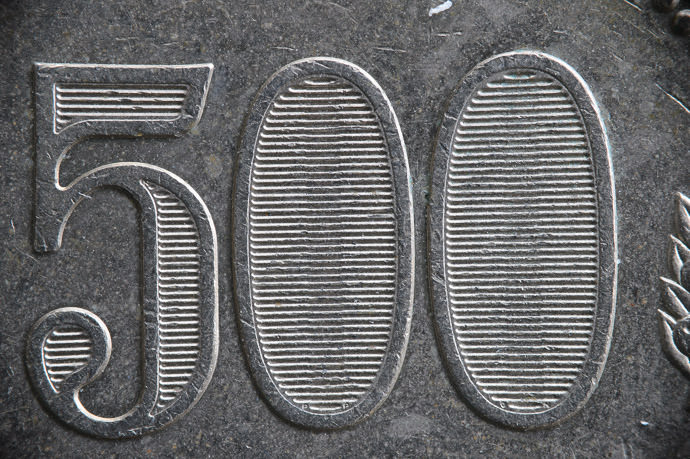
Nikon D4 + Venus 60mm Super Macro f/2.8 — 1/15 sec, f/8, ISO 1600 — map & image data — nearby photos
Japanese Coin
can you guess how many yen it's worth?
I should preface my comments to note that I don't have much experience with macro photography beyond some stupid macro tricks seven years ago with a reversed lens, and general use over the years with a Voigtländer 125mm f/2.5, which is a full 1:1 macro. The new Venus/Laowa lens is a 2:1 macro.
So we're clear on the terminology, the phrases “full macro” or “1:1 macro” mean that the lens can project a life-size image of an object onto the sensor or film. How big that sensor or film frame is in physical size or pixel dimensions is not relevant to the phrase, though of course what camera/sensor you couple the lens with has a direct impact of the results you'll see.
A 1:1 projection of a medium-sized postage stamp might fill the sensor of a “full frame” camera like a Nikon D4 or a Canon EOS 5D, but be substantially cropped on a camera with a smaller sensor, or only partially fill the frame of a medium-format camera. But in all cases, the lens and the projected image are the same.
This new Venus/Laowa lens is a 2:1 macro, meaning that it can project a double-life-size image onto the sensor. A bigger projection means more detail in the result, at least if the lens has the quality to back it up.
As other reviews have mentioned, the thing arrives in a shrink-wrapped bag, which gives a decidedly “cheap” feeling:
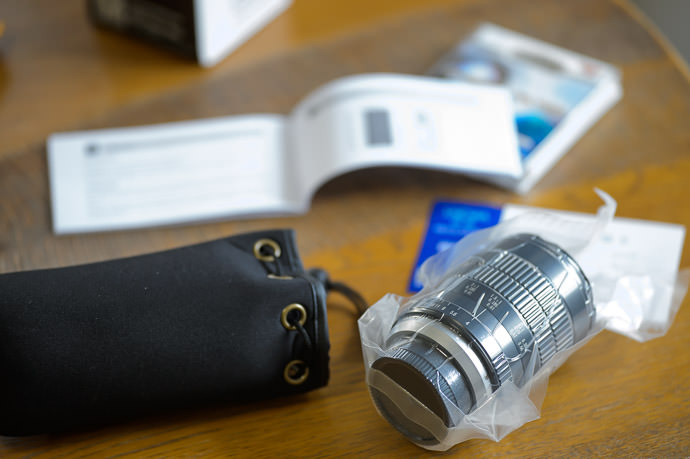
Nikon D4 + Voigtländer 125mm f/2.5 — 1/640 sec, f/2.5, ISO 4000 — map & image data — nearby photos
Arrival
The lens' box was somewhat disheveled, so at first I worried that I'd gotten a used copy, but the shrinkwrap helped assuage that feeling. The lens glass and barrel was pristine, and had enough heft to dispel the “cheap” feeling that the shrinkwrap had initially imparted.
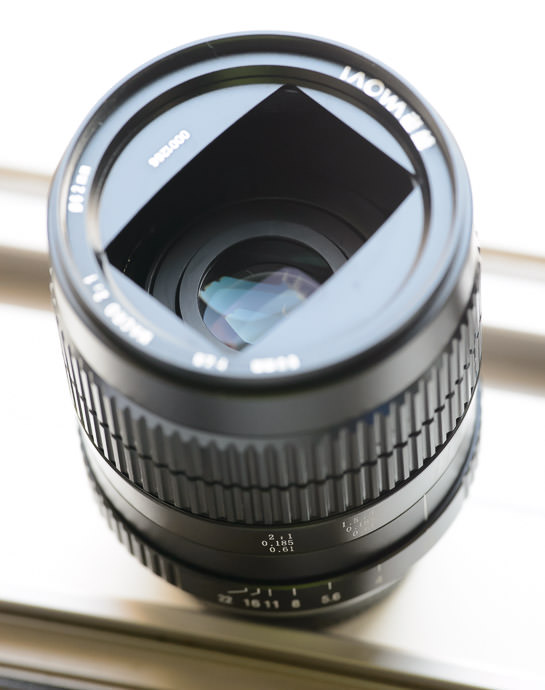
Nikon D4 + Voigtländer 125mm f/2.5 — 1/400 sec, f/4, ISO 6400 — map & image data — nearby photos
Weird
the lens retracts into itself when focusing at a distance
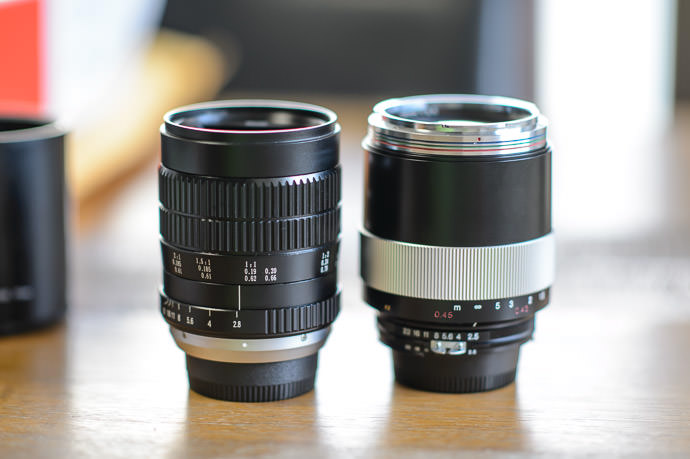
Nikon D4 + Nikkor 85mm f/1.4 — 1/400 sec, f/1.6, ISO 800 — map & image data — nearby photos
About the Same Size as a Voigtländer 125mm
not quite in the same class in terms of build quality, but good enough for ⅕ the price
When it first arrived a week ago, the late-afternoon sun was quickly retreating behind increasing gloom, so just to play a bit I threw some things on a windowsill for a few quick handheld not-much-light snaps. My first impression on seeing the following shot was that the lens distortion was really noticeable...
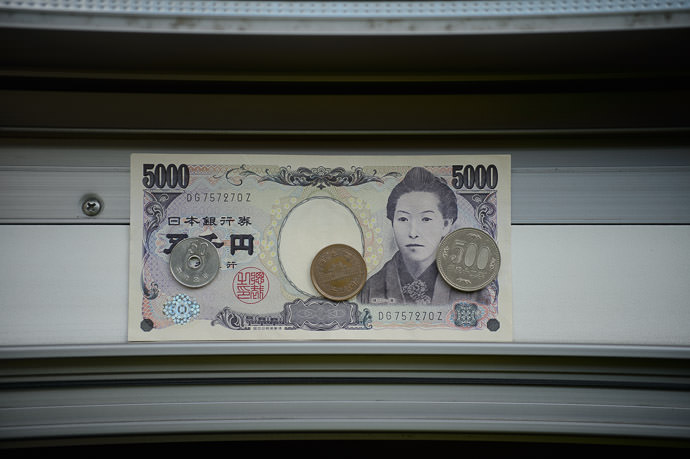
Nikon D4 + Venus 60mm Super Macro f/2.8 — 1/200 sec, f/2.8, ISO 110 — map & image data — nearby photos
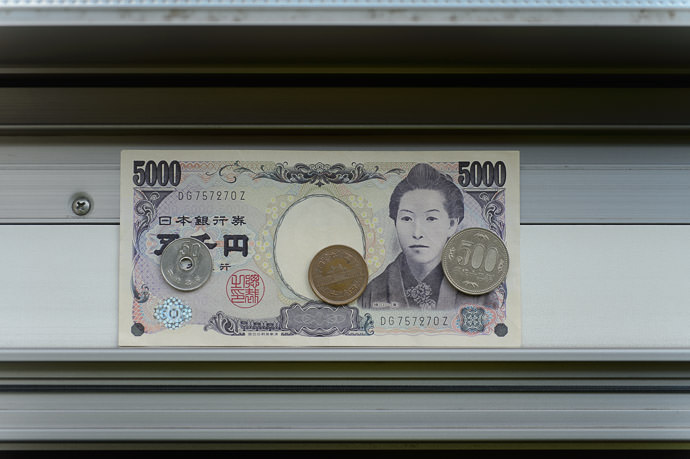
Nikon D4 + Venus 60mm Super Macro f/2.8 — 1/200 sec, f/2.8, ISO 110 — map & image data — nearby photos
mouseover a button to see that image
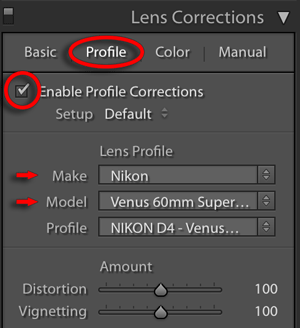
The distortion and vignetting, both of which can be severe, are easily corrected in Lightroom or ACR with a lens profile created by Adobe's Lens Profile Creator, which they generously provide for free. The download includes everything you need to get going: the application, instructions, and printable targets. It's all quite easy.
So, as you might expect, the “corrected” version above is with the lens profile applied.
If you'd like to try the simple profile I created, you can download it here, saving it as “NIKON D4 (Venus 60mm Super Macro f2.8) - RAW.lcp” in your “Library/Application Support/Adobe/CameraRaw/LensProfiles/1.0” folder on OSX, or its equivalent on Windows.
You can probably get reasonable results with any camera. I created the profile using Nikon D4 raw files, but you can manually apply it to photos taken with any make and model camera. As illustrated at right, in the Develop Module's Lens Corrections' “Profile” tab, select “Nikon” (because that's the body make I used when creating the profile), then the “Venus 60mm...” model from there.
Jumping ahead a bit to later sessions with the lens, I found a tiny graph-paper illustration in my son's old fifth-grade math textbook that I could use for some tests. Here's the same scene shot at f/2.8 and f/8, with and without correction in Lightroom. At f/2.8, sharpness falls off drastically as you move away from the center, and of course that can't be corrected the same way distortion and vignetting can...
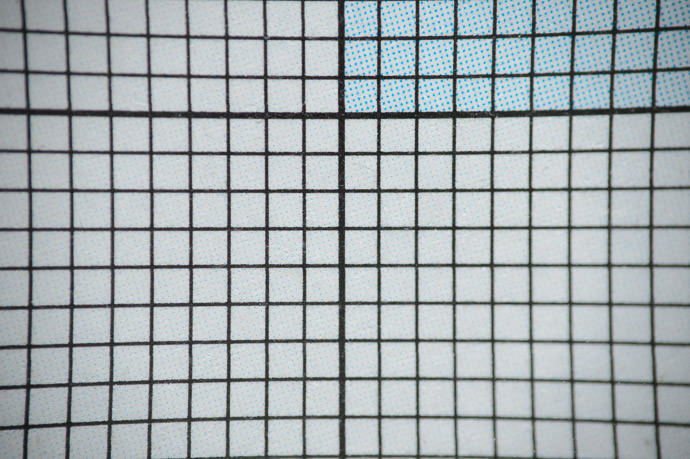
Nikon D4 + Venus 60mm Super Macro f/2.8 — 1/60 sec, f/2.8, ISO 100 — map & image data — nearby photos
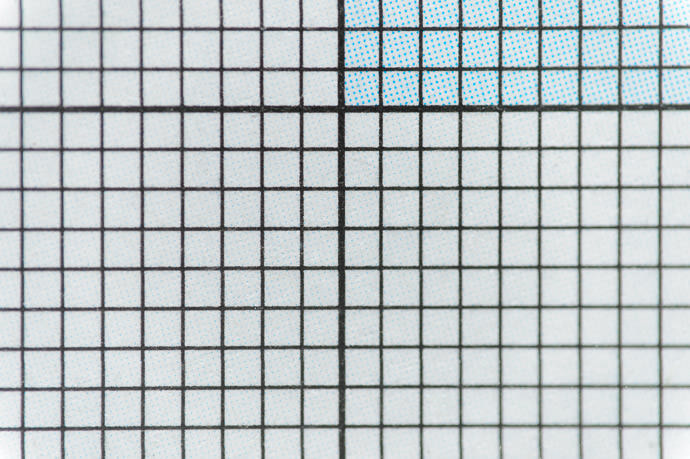
Nikon D4 + Venus 60mm Super Macro f/2.8 — 1/60 sec, f/2.8, ISO 100 — map & image data — nearby photos
| f/2.8 | f/2.8 corrected |
| f/8 | f/8 corrected |
| mouseover a button to see that image | |
Jumping back and forth between the f/2.8 and f/8 versions really makes the lack of sharpness at f/2.8 readily apparent. (You'll appreciate that I refrained from saying that it “..made the sharpness clear. ” 😉 )
The non-center softness is probably not a problem for many kinds of photos this lens would be used to take, and for the kind of photo where it matters (where you want the whole flat object to be in focus), it's probably not a moving subject and you can stop down for better sharpness, at least if using a tripod like one should. Back to the lens-arrival day, I was just snapping some quick shots by hand, sometimes bracing the camera against the window. Here's a 2:1 macro shot of part of the banknote seen above.
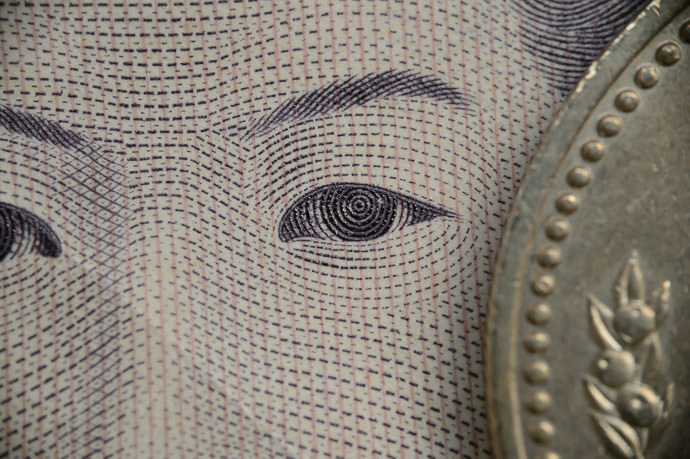
Nikon D4 + Venus 60mm Super Macro f/2.8 — 1/200 sec, f/8, ISO 1800 — map & image data — nearby photos
Full-on 2:1 Macro (Handheld)
The small images embedded on this post are drastically reduced copies, of course, but clicking through on any of them goes to the full-size (uncropped) full resolution (un-shrunk) version of the respective shot.
Just to include a bit of un-shrunk full-resolution result directly in the article, here's a tiny bit out of the shot above...
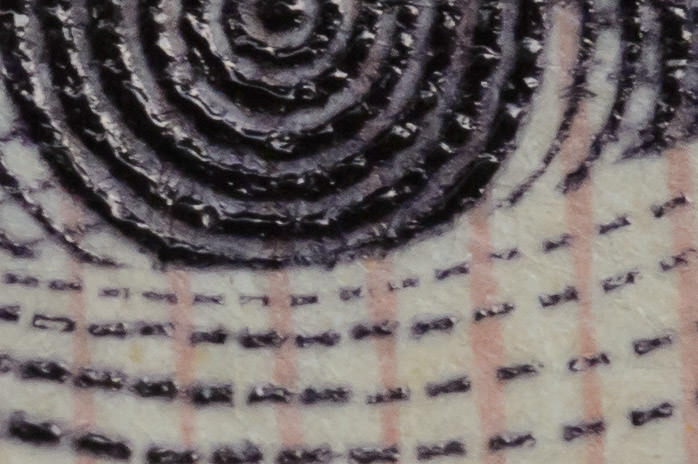
full-resolution crop (1/50th the area of the whole frame) from the shot above
not great, but not too bad for a handheld, natural-light shot
While we're at it, here's a full-resolution crop from the uncorrected f/8 grid shot above:
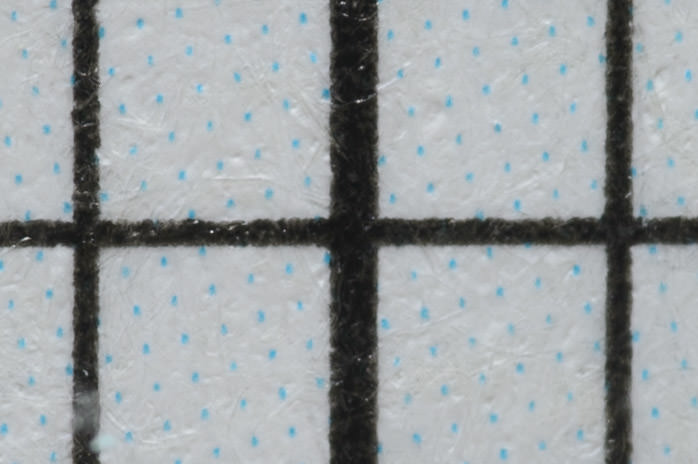
Nikon D4 + Venus 60mm Super Macro f/2.8 — 1/60 sec, f/8, ISO 100 — map & image data — nearby photos
f/8 uncorrected full-resolution crop (1/50th the area of the whole frame)
As other reviews mention, there's absolutely no communication between the camera and lens. When one hears “non-CPU lens”, there's normally at least a mechanical coupling so that the lens can communicate its current aperture to the camera, but with this Venus/Laowa lens, there's nothing. When you mount the lens, the camera doesn't even know something's there, much less what it is and what its aperture ring is dialed to.
At least on prosumer Nikon bodies, you can set the “Non-CPU lens data” in the setup menu:
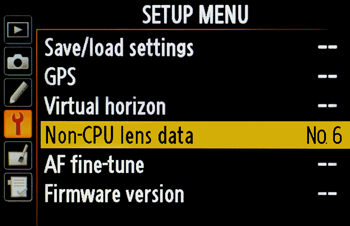
Sadly, as with many things, Nikon doesn't make this as simple as it should be...

We'd like to denote that we're using a lens with a 60mm focal length, but “60” is not one of the choices available. I run into this problem a lot... I need “420” when using my Nikkor 300mm f/2 with its dedicated 1.4×TC, but Nikon doesn't allow for it here. I need “125” with my aforementioned Voigtländer 125mm f/2.5, but it doesn't include that either. Sigh.
So, for my new 60mm lens I go with “70”.
Normally you'd set the maximum aperture size (minimum aperture number for your lens — F2.0 for the 300mm lens mentioned above), and the mechanical linkage between the lens and the camera would tell the camera what aperture the lens was actually dialed to for any particular shot, but since our super-macro doesn't have that linkage, instead of the maximum aperture, set the actual aperture you're using. For each shot.
This means that if you want the aperture properly encoded in each image's metadata, you've got to visit this menu every time you make an aperture change. That's 11 or 12 button presses per aperture change. Sigh. I don't envision using this lens except for special macro needs, so it's a hassle I'll live with.
Even if you've gone through all the “Non-CPU lens data” hassle, Lightroom still shows the lens as “0.0 mm f/0.0”, which is frustrating to say the least, and a metadata geek like me can't put up with that, so prior to importing the raw files into Lightroom, I update them with proper metadata. (It's abhorrent to me to modify a raw file so this is painful, but to me the wrong metadata is even worse.)
I update the files with a custom Perl script, but in effect it uses Phil Harvey's exiftool under the hood, along the lines of this command-line invocation (which should all be on a single line; it's broken up here for legibility):
% exiftool -Lens="Venus 60mm Super Macro f/2.8"
-MaxApertureValue=2.8
-MaxApertureAtMaxFocal=2.8
-MaxApertureAtMinFocal=2.8
-FocalLength=60
-MinFocalLength=60
-MaxFocalLength=60
-FocalLengthIn35mmFormat=60 *.NEF
I really wish Lightroom would let users edit this data so we wouldn't have to go through these kinds of silly hoops. I've made feature requests, but so far to no avail.
Knowing the limitations of what Lightroom lets plugins do, I know that a plugin can't do everything that I want in this area, but if your needs are less demanding, the LensTagger Lightroom Plugin apparently lets you denote some of the lens info from within Lightroom.
Okay, anyway, back to the day the lens arrived...
Since I had it handy, I also snapped some close-ups of the used bicycle brake pad I'd just had swapped out of my bicycle after my 90km mountain ride. One of the shots appeared as the “Dark, Striated” What-Am-I? quiz the other day...
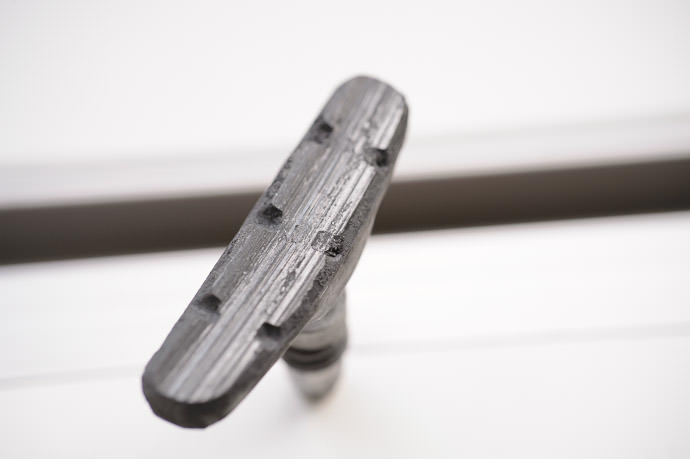
Nikon D4 + Venus 60mm Super Macro f/2.8 — 1/400 sec, f/4, ISO 1600 — map & image data — nearby photos
It Gave Me a Brake
A few days later I took a step toward proper shots by breaking out the tripod...
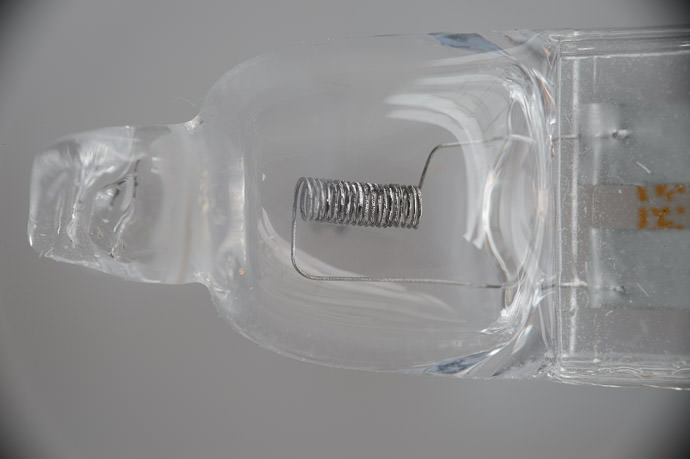
Nikon D4 + Venus 60mm Super Macro f/2.8 — 2 sec, f/11, ISO 100 — map & image data — nearby photos
Tiny Halogen Bulb
my capture method was not such a bright idea
The results were unfulfilling because of camera shake. Even with a tripod, at this magnification the slightest shake manifest itself in the viewfinder like a seismograph going crazy, so a two-second shot like the light bulb above becomes mired in detail-stealing blur.
Still, I'll share two other shots from that session, of the hologram thingie from the lower left of a Japanese 5,000-yen banknote (such as seen in the windowsill shot above).
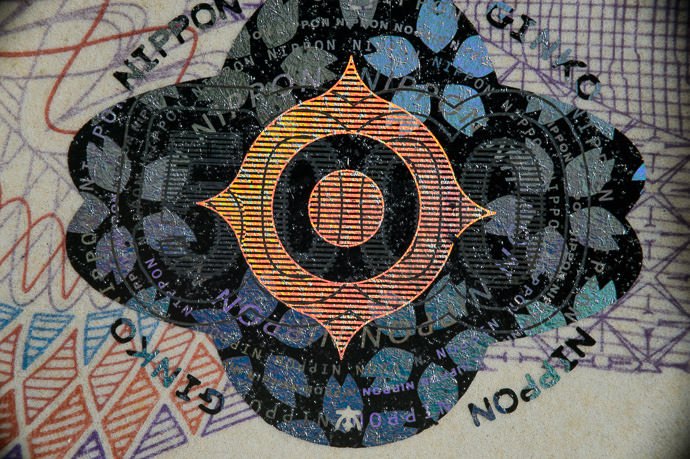
Nikon D4 + Venus 60mm Super Macro f/2.8 — 0.8 sec, f/16, ISO 100 — map & image data — nearby photos
One Angle...
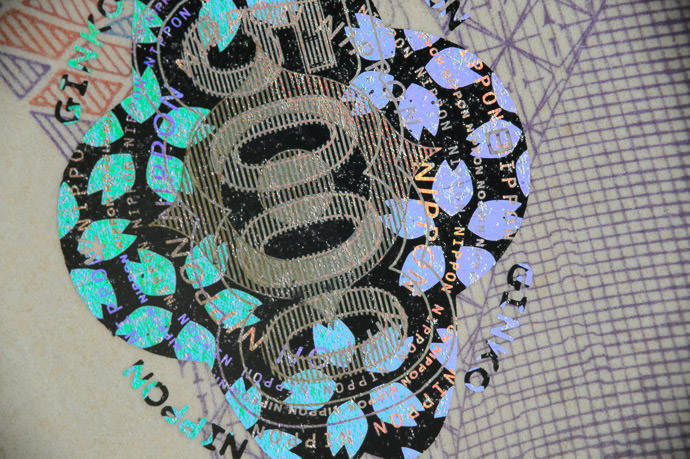
Nikon D4 + Venus 60mm Super Macro f/2.8 — 0.5 sec, f/8, ISO 100 — map & image data — nearby photos
... and Another
Anyway, really needed a flash to eliminate blur due to shake, so I broke out the speedlights and spent Monday afternoon putzing around the house looking for things that might make interesting photos.

Nikon D4 + Venus 60mm Super Macro f/2.8 — 1/60 sec, f/8, ISO 100 — map & image data — nearby photos
2:1 Strawberry at f/8
it was delicious
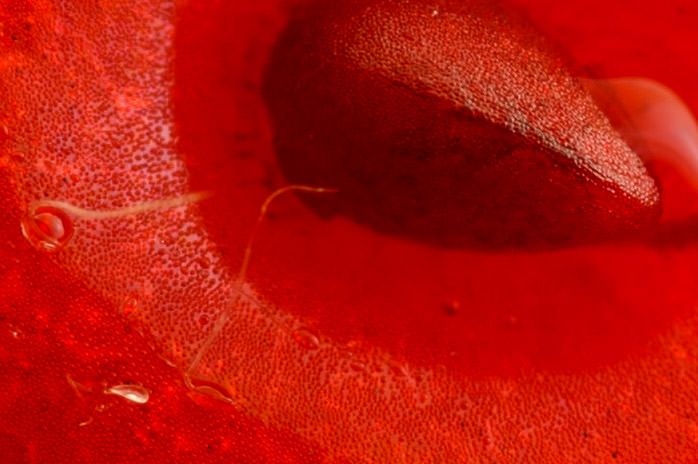
full-resolution crop from the shot above (1/50th the area of the full image)

Nikon D4 + Venus 60mm Super Macro f/2.8 — 1/60 sec, f/2.8, ISO 100 — map & image data — nearby photos
2:1 Strawberry at f/2.8
I was happy to have a 2:1 macro, but had to push the limit, so I reached into my bag of stupid macro tricks and added 68mm of extension tubes between the lens and the camera. This results in a 3:1 macro.
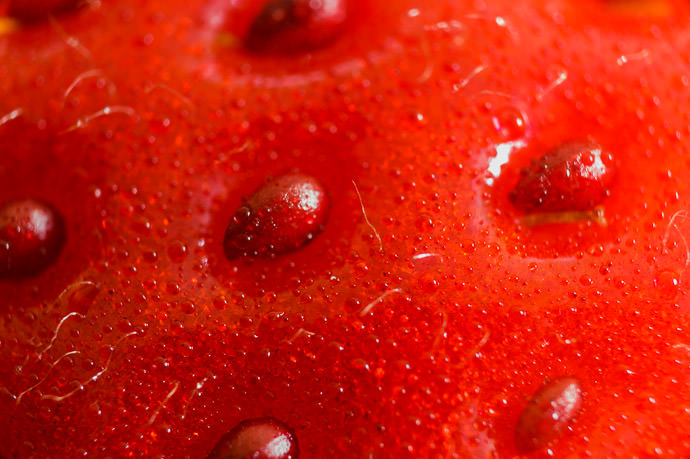
Nikon D4 + Venus 60mm Super Macro f/2.8 + 68mm extension tubes — 1/60 sec, f/8, ISO 640 — map & image data — nearby photos
3:1 Strawberry
Finally, I added a Sigma 2× TC, which, for optical reasons I don't understand, resulted in an overall 8:1 macro. Here again is the lead photo of this article, properly captioned:

Nikon D4 + Venus 60mm Super Macro f/2.8 + 68mm extension tubes + 2x teleconverter — 1/60 sec, f/8, ISO 100 — map & image data — nearby photos
8:1 Macro of a Strawberry Seed
Here's a shot of the setup...
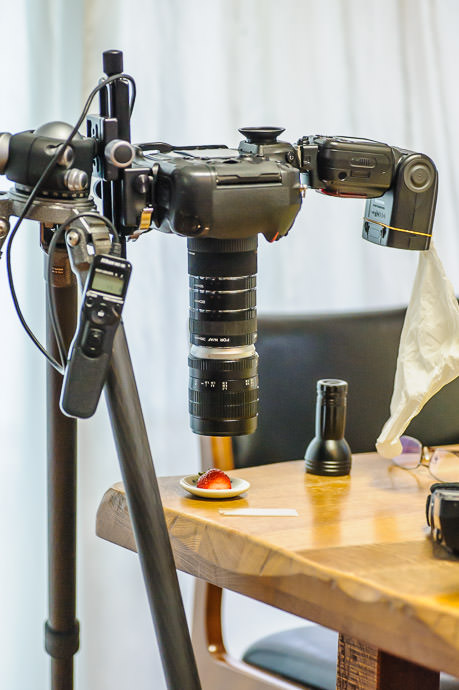
Nikon D700 + Voigtländer 125mm f/2.5 — 1/400 sec, f/2.5, ISO 4500 — map & image data — nearby photos
8:1 Macro Setup
Nikon D4 body on top (with an SB-910 flash unit attached), the Sigma TC, three extension tubes totaling 68mm, and finally the Venus/Laowa itself. It's connected to the tripod via a Really Right Stuff BH-55 ballhead, an exceedingly exquisite piece of craftsmanship, and a Really Right Stuff macro focusing rail, the only Really Right Stuff product that I've been disappointed with (its movement is sloppy).
I'd chosen to have all the lens stuff pointing straight down to eliminate torque on the camera body mount, but this had a side effect I should have handled better: without any weight to “anchor” the lens, it could “swing” and oscillate microscopically at the slightest provocation, and due to the high magnification, the slightest such movement was rendered monumentally in the frame. I think that I could literally see the effect of my heartbeat reflected in the oscillation in the live-view display, traveling through my body, into the floor, to the tripod legs, and up to the camera and lens.
Next time I'll have to try something else, but for the moment I was hoping that the flash was sufficient for a sharp result.

Nikon D4 + Venus 60mm Super Macro f/2.8 + 68mm extension tubes — 1/60 sec, f/8, ISO 640 — map & image data — nearby photos
Standard LEGO™ Minifig
with extension tubes and lens
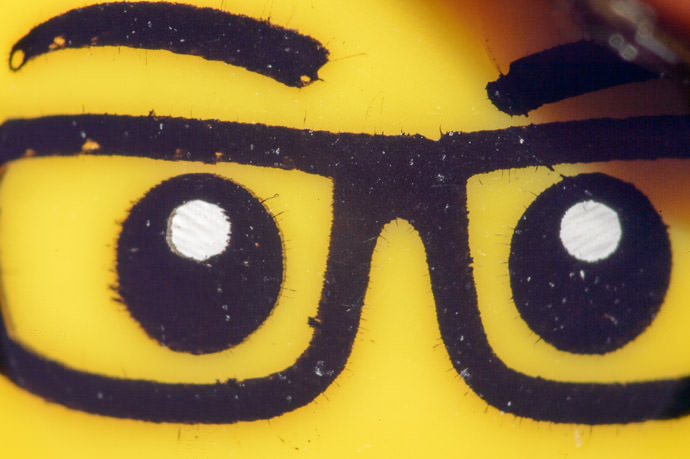
Nikon D4 + Venus 60mm Super Macro f/2.8 + 68mm extension tubes + 2x teleconverter — 1/60 sec, f/8, ISO 100 — map & image data — nearby photos
... plus 2×TC Yields Minifig @ 8:1
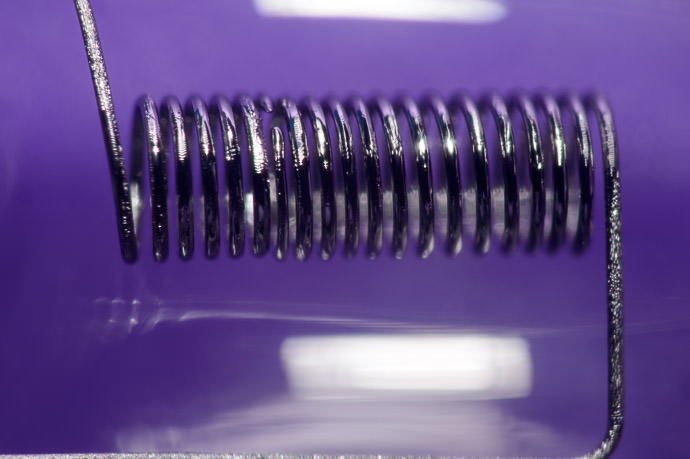
Nikon D4 + Venus 60mm Super Macro f/2.8 + 68mm extension tubes + 2x teleconverter — 1/60 sec, f/8, ISO 100 — map & image data — nearby photos
Halogen Bulb @ 8:1
in the left half, you can see where it melted
( this is the same kind of bulb seen above )
This halogen-bulb shot illustrates one of the most important things I learned during these experiments: just how ridiculously dirty my camera's sensor was. Something about the extreme macro combined with the flash made the result hyper-sensitive to dirt/dust/crud on the sensor, causing the results to be a veritable star field of failure.
In any one individual shot I found literally 10× the number of spots that I'd seen in total over the last 10 years.
I spent some time to clean up the spots with Lightroom's spot healing tool, but even though the shot above has 612 such corrections(!), clicking through to the full-resolution version shows many more that I just didn't have the energy to deal with.
But for a taste of what I was dealing with, here's a full-resolution crop without the spot-removal corrections:
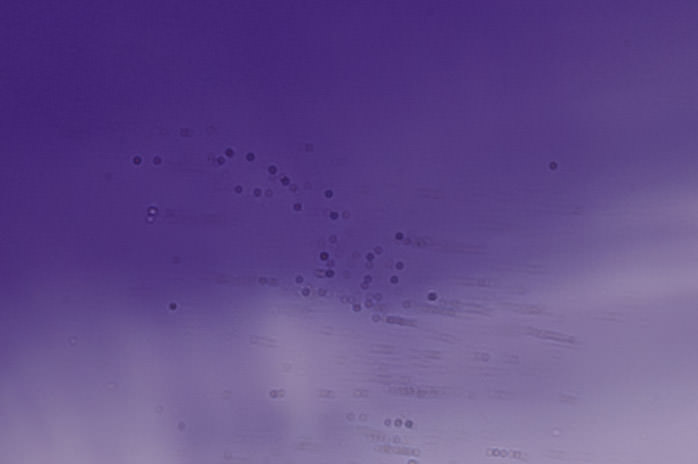
My Sensor Shame
tiny crop (1/50th the area of the whole sensor) at full resolution
Did I let a dog lick the sensor or something?
I think I see the Big Dipper
Not every photo needed as much work as this one... often, the spots were lost in the detail of the shot, at wider apertures they don't show up as much, and even for me there's a limit to how much energy I'll spend for my blog. Overall the photos on this post have 2,147 spot corrections, which perhaps says as much about my level of anality as it does about my sensor.
(I didn't count the spots by hand... my Data Explorer plugin counted them for me.)
Checking for sensor dirt the way I normally do, with a normal lens and without a flash, showed just a few of the more egregious spots. If that's all I'd seen, I'd have been unconcerned and simply gotten the blower out to give the sensor a quick once-over. But this was well beyond my ability to deal with, so I headed directly to Nikon's Osaka service center yesterday to have them clean it.
(I brought the lens and a flash to test how well they did while still at the service counter, and had to send it back for a more-thorough cleaning. They were patient as I did my strange test, but probably had never seen anything like it.)
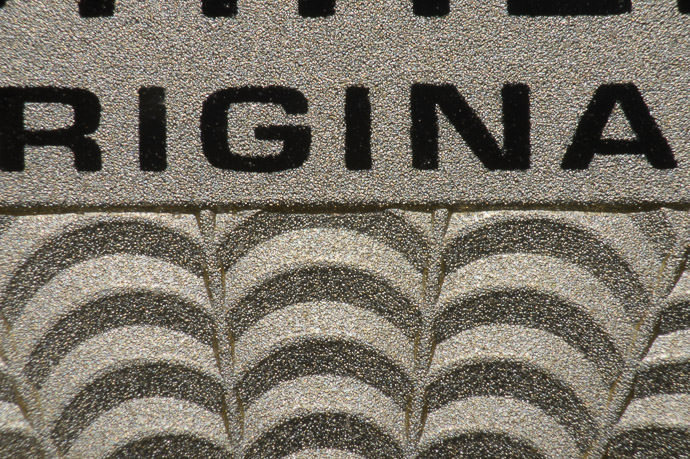
Nikon D4 + Venus 60mm Super Macro f/2.8 + 68mm extension tubes + 2x teleconverter — 1/60 sec, f/8, ISO 100 — map & image data — nearby photos
My Watch @ 8:1
this watch

Nikon D4 + Venus 60mm Super Macro f/2.8 — 1/60 sec, f/8, ISO 100 — map & image data — nearby photos
Toothbrush @ 8:1
the answer to the “Otherworldly What-am-I Quiz”
Back to the straight 2:1 macro...

Nikon D4 + Venus 60mm Super Macro f/2.8 — 1/60 sec, f/8, ISO 100 — map & image data — nearby photos
Shaver

Nikon D4 + Venus 60mm Super Macro f/2.8 — 1/60 sec, f/8, ISO 100 — map & image data — nearby photos
Nylon String
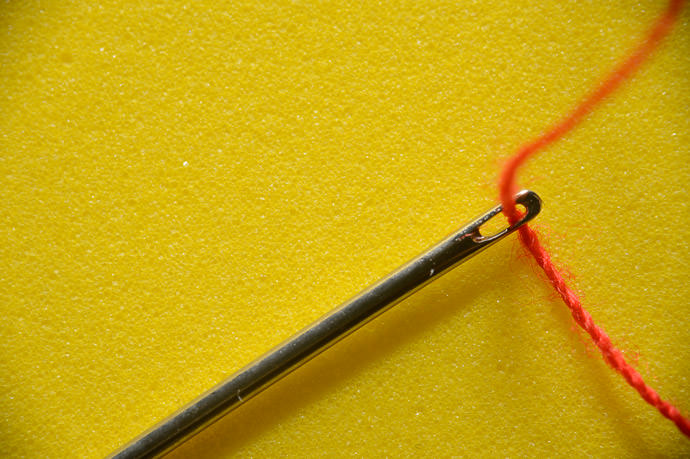
Nikon D4 + Venus 60mm Super Macro f/2.8 — 1/60 sec, f/8, ISO 100 — map & image data — nearby photos
Standard Needle
not a big leather-use needle... a standard not-much-bigger-than-a-pin needle and thread
( unfortunately, I missed focus on the needle, getting slightly behind it. )
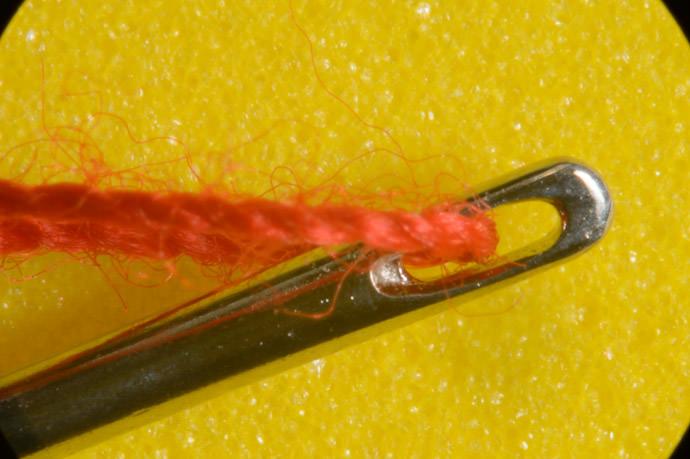
Nikon D4 + Venus 60mm Super Macro f/2.8 + 68mm extension tubes + 2x teleconverter — 1/60 sec, f/22, ISO 100 — map & image data — nearby photos
Needle @ 8:1
( again with missed focus 🙁 )
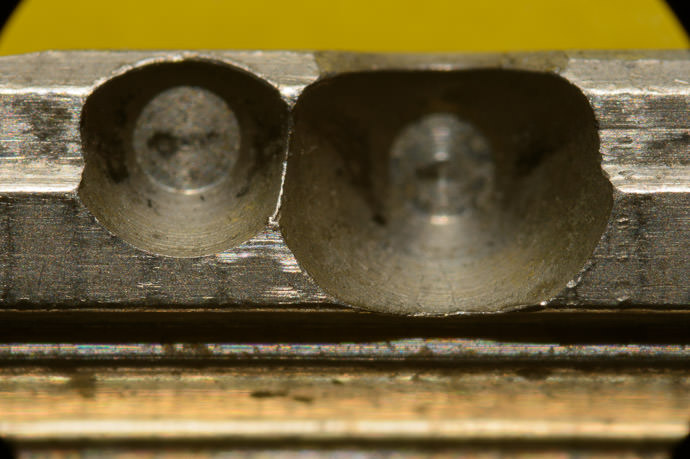
Nikon D4 + Venus 60mm Super Macro f/2.8 + 68mm extension tubes + 2x teleconverter — 1/60 sec, f/11, ISO 100 — map & image data — nearby photos
Modern Key @ 8:1
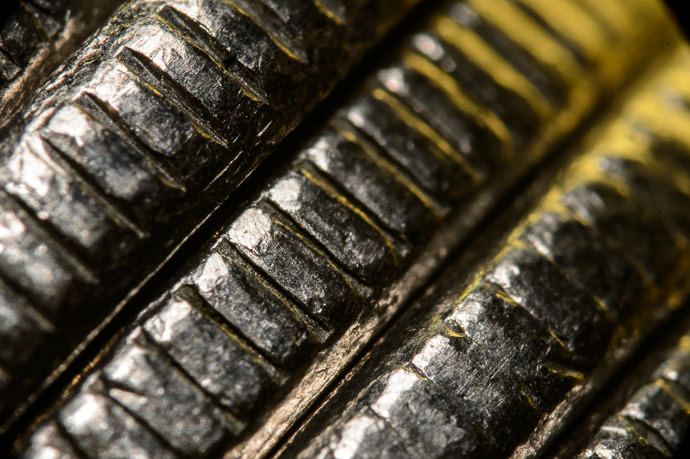
Nikon D4 + Venus 60mm Super Macro f/2.8 + 68mm extension tubes + 2x teleconverter — 1/60 sec, f/11, ISO 100 — map & image data — nearby photos
Japanese 50-Yen Coins Edge On
I used 50-yen coins because I could stick a toothpick through them and then bind them tightly together with a rubber-band around the ends of the toothpick. You can see a 50-yen coin and its doughnut center at the left side of the money shot above.
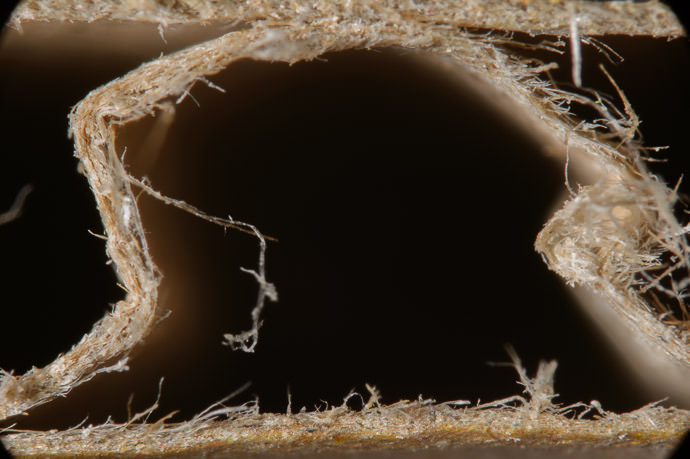
Nikon D4 + Venus 60mm Super Macro f/2.8 + 68mm extension tubes + 2x teleconverter — 1/60 sec, f/8, ISO 100 — map & image data — nearby photos
Corrugated Cardboard on Edge @ 8:1
courtesy of Amazon Japan
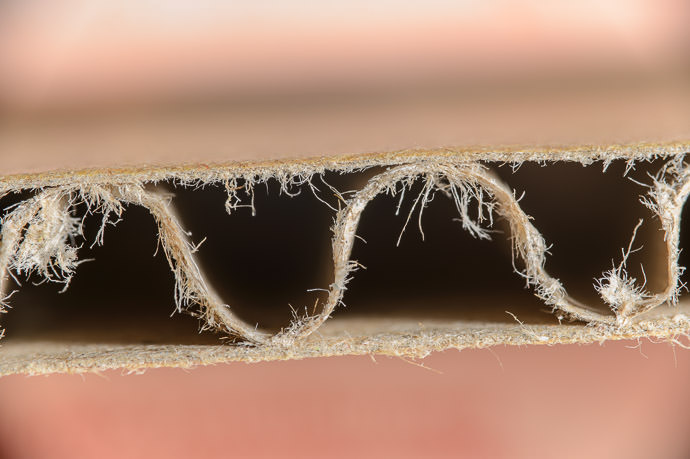
Nikon D4 + Venus 60mm Super Macro f/2.8 — 1/60 sec, f/8, ISO 100 — map & image data — nearby photos
Amazon Cardboard @ 2:1
I learned a lot from these fairly haphazard experiments. In the end the lens' quality exceeds my skill, so I'm happy with my purchase. For less than US$400, it's a great value if you know how to use it... something I aspire to.
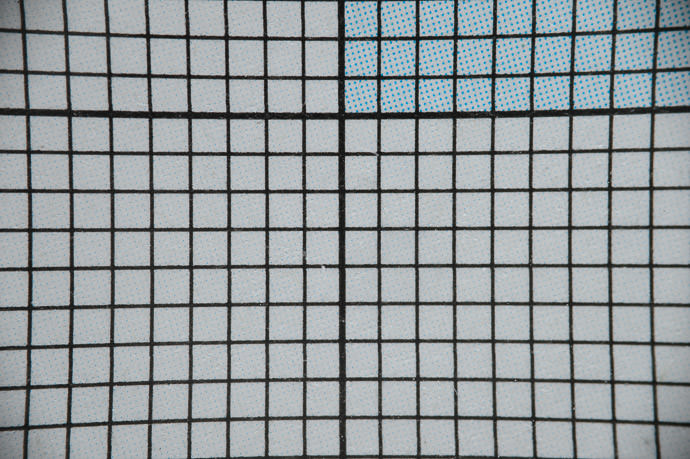
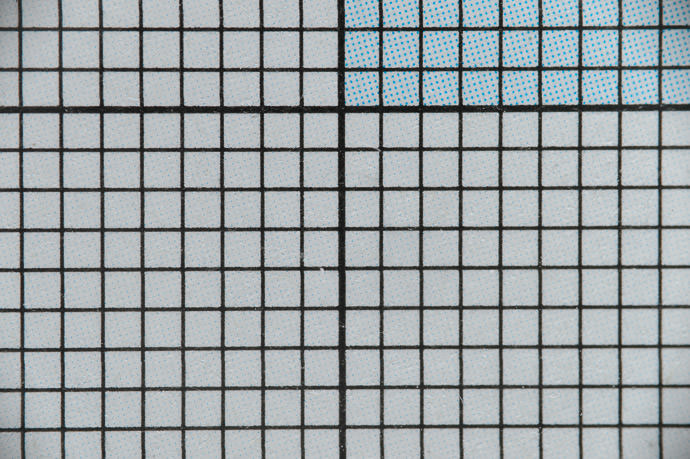
Glad you did your review on the lens, I was curious about how it performed too.
Alvin from NYC.
Nice “not a review” 😉 It reminds me that I haven’t broken out all the super-macro gadgetry I’ve accumulated in quite a while…
Useful overview, thanks, Jeffrey; and you’ve shown us quite a bit that other reviews haven’t. 2:1 is impressive, but it looks like it has some optical limitations, and could be a bit awkward in use. It will certainly be interesting to see if the company produces any further unusual lenses.
Great pictures, craazy macro…
Laowa 「老蛙」 is the nickname who developped this len.
I got his lens last week from the supplier direct. It is sharp but makes lot of sound when you rotate the lens magnification ring. The supplier confirmed that this was a design defect and nothing can be done with this release. Besides, the lens is open from the front attracting dust and causing further damage unless you keep a filter always in the front.
I assume your extension tubes are the non-electronic variety as I have the electronic version and they don’t fit together with the TC as the protruding optical element gets in the way of fitting. Can you please confirm. Thanks 🙂
You are correct… “extension tubes” are just that… empty tubes. Your protruding-element thing is a teleconverter (TC), which is not an extension tube. 🙂 One has to be careful with TCs… using ones that don’t happen to work together can physically damage the camera and/or lens. —Jeffrey
Hi, I am from Argentina, one query, if I am at f22 or f11, how dark is the view in the viewfinder? also in the live view mode can you focus properly or it is a headache?
Cheers!!.
As you stop down, it gets dark, though how dark depends on how bright the scene is. With a normal lens the aperture is kept open until the moment of the shutter click, so you’re always looking through its most-bright size while composing the shot, but this lens doesn’t have that feature, so when you stop it down, it’s stopped down. When I’m using a tripod, I generally focus with live view while wide open, then stop down to take the shot. Focusing in live view is great when on a tripod, not so great (for me) otherwise. —Jeffrey
Jeffrey, this dark problem could be fixed mounting a led light home made or like the Venus KX800 twin flash? did you try this?
I haven’t. I doubt a flash would help while focusing, since it just flashes when the exposure is made. To help during focus, you need a continuous light. Direct sunlight is generally good in this regard. —Jeffrey
I often shoot reversed macro between 4 and 8x i honestly don’t think your pics are 8x magnification
Perhaps I calculated it incorrectly; viewing a ruler and sighting the width of the frame as 4.5mm, that seems to be 1/8th the width of the actual sensor. Maybe that’s the wrong way to calculate magnification. —Jeffrey
Yes, Mat is right. You are shooting at a (still very impressive) 6.26x. 2x lens, and then the 68mm extension takes you to 3.13x (would be exactly 3.00x with a 60mm extension). Then the 2x teleconverter doubles it, so you get to 6.26x.
You also lose a bit over four stops of light. The extension tubes are almost the same as the lens focal length, so that’s (just over) two stops there. Then another two stops for the TC, and your f/2.8 lens is about an f/11 (well, closer to f/12).
This is one of the downsides of extension tubes over TCs – if you had just stacked two 2x TCs with no tubes, you would have got the full 8x magnification (2x->4x->8x) and lost the same four stops of light as you did with the tubes and single TC for 6.26x.
That said, teleconverters have glass in them so they can certainly degrade image quality more than extension tubes, especially when stacked. A stack of three 2x TCs would get you to 16x magnification, but you’d also be at f/22 and probably pretty questionable image quality!
Anyway, thanks for the great article! I think the 60mm is going to be my next lens purchase, it looks really fun.
Sydney Australia
Have just ordered the Venus 60mm and am wanting to purchase a 2x TC to extend the working distance (wanting to do insect photography and 6cm is so close!). Just wondering which Sigma TC it was that you used? And would other TCs work too, without extension tubes in between? I’ve been looking at the Kenko mc7 as an option.
Thanks for all the info on the lens – it’s one of the reasons why I decided to purchase it 🙂
Thanks for the kind words. The Sigma TC is the one that came with the 50-500 “Bigma”, just because I had it lying around and it could physically fit. You have to be very careful when trying to fit a TC to a lens… sometimes they can’t physically fit. I was just mixing and matching and trying different things, all without the burden of real knowledge 🙂 —Jeffrey